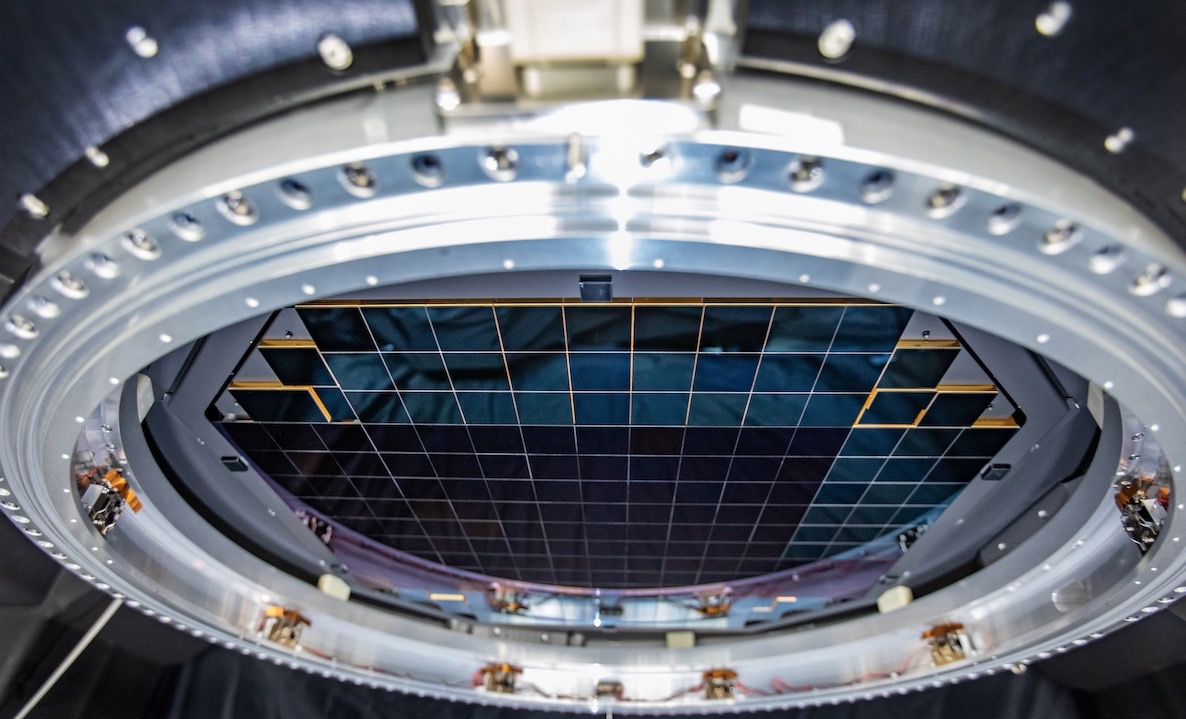
The camera core for the future Vera C. Rubin Observatory has snapped its first test photos, setting a new world record for the largest single shot by a giant digital camera.
The imaging sensor array, which comprises the focal plane for Vera Rubin's SUV-sized digital camera, snapped the 3,200-megapixel images during recent tests at the Department of Energy's (DOE) SLAC National Accelerator Laboratory in California. ("SLAC" stands for "Stanford Linear Accelerator Center," the facility's original name.)
The photos are the largest single-shot pictures ever taken, SLAC officials said — so big that showing just one of them full-size would require 378 4K ultra-high-definition TVs. The resolution is so good that a golf ball would be visible from 15 miles (25 kilometers) away.
Vera Rubin: The astronomer who brought dark matter to light
The first images don't show distant golf balls, however. The SLAC team that's building Vera Rubin's LSST (Legacy Survey of Space and Time) Camera focused on nearby objects, including a Romanesco broccoli, whose intricately textured surface allowed the sensors to strut their stuff.
"Taking these images is a major accomplishment," SLAC scientist Aaron Roodman, who's responsible for the assembly and testing of the LSST Camera, said in a statement. "With the tight specifications, we really pushed the limits of what's possible to take advantage of every square millimeter of the focal plane and maximize the science we can do with it."
Like the imaging sensor in your smartphone camera, the LSST Camera's focal plane converts light emitted or reflected by an object into electrical signals that generate a digital photo. But the LSST Camera's imaging core is far larger, more complex and more capable than any consumer electronic product.
Breaking space news, the latest updates on rocket launches, skywatching events and more!
The newly tested focal plane is more than 2 feet (0.6 meters) wide and harbors 189 individual sensors, or charge-coupled devices (CCDs). The CCDs and their associated electronics are housed in 21 separate "rafts," subunits that are about 2 feet tall, weigh about 20 lbs. (9 kilograms) and cost up to $3 million apiece.
The rafts were built at the DOE's Brookhaven National Laboratory in New York and then transported to SLAC. In January 2020, the SLAC team finished slotting the 21 sensor-bearing rafts, plus another four specialty rafts not used for imaging, into their assigned places in the focal-plane grid, an exacting and nerve-wracking process that took about six months.
The rafts are packed incredibly tightly to maximize the focal plane's imaging area; the gap between CCDs on neighboring rafts is less than the width of five human hairs, SLAC officials said. And the sensors are fragile, cracking easily if they touch one another.
Related: The world's largest telescopes: How they stack up

"The combination of high stakes and tight tolerances made this project very challenging," SLAC mechanical engineer Hannah Pollek, a member of the sensor-integration team, said in the same statement. "But with a versatile team, we pretty much nailed it."
The newly released images, which you can find here, are part of extensive, ongoing tests designed to vet the focal plane, which has not yet been installed on the LSST Camera. That integration step will happen in the next few months, as will the addition of the camera's lenses and other key components, if all goes according to plan.
The camera should be ready for final testing by the middle of next year, SLAC officials said. It will then be shipped to the Chilean Andes, where the Vera C. Rubin Observatory is being built.
The observatory, previously known as the Large Synoptic Survey Telescope, will use its 27.6-foot-wide (8.4 m) mirror and 3.2-billion-pixel camera to conduct a landmark 10-year study of the cosmos — the Legacy Survey of Space and Time for which the camera is named. The camera will generate a panorama of the southern sky every few nights, amassing an astronomical treasure trove that will include imagery of about 20 billion different galaxies.
"These data will improve our knowledge of how galaxies have evolved over time and will let us test our models of dark matter and dark energy more deeply and precisely than ever," Steven Ritz, project scientist for the LSST Camera at the University of California, Santa Cruz, said in the same statement.
"The observatory will be a wonderful facility for a broad range of science — from detailed studies of our solar system to studies of faraway objects toward the edge of the visible universe," Ritz said.
Editor's note: This story was updated at 10:45 a.m. EDT on Sept. 9 with a link to the newly released photos.
Mike Wall is the author of "Out There" (Grand Central Publishing, 2018; illustrated by Karl Tate), a book about the search for alien life. Follow him on Twitter @michaeldwall. Follow us on Twitter @Spacedotcom or Facebook.

Michael Wall is a Senior Space Writer with Space.com and joined the team in 2010. He primarily covers exoplanets, spaceflight and military space, but has been known to dabble in the space art beat. His book about the search for alien life, "Out There," was published on Nov. 13, 2018. Before becoming a science writer, Michael worked as a herpetologist and wildlife biologist. He has a Ph.D. in evolutionary biology from the University of Sydney, Australia, a bachelor's degree from the University of Arizona, and a graduate certificate in science writing from the University of California, Santa Cruz. To find out what his latest project is, you can follow Michael on Twitter.
